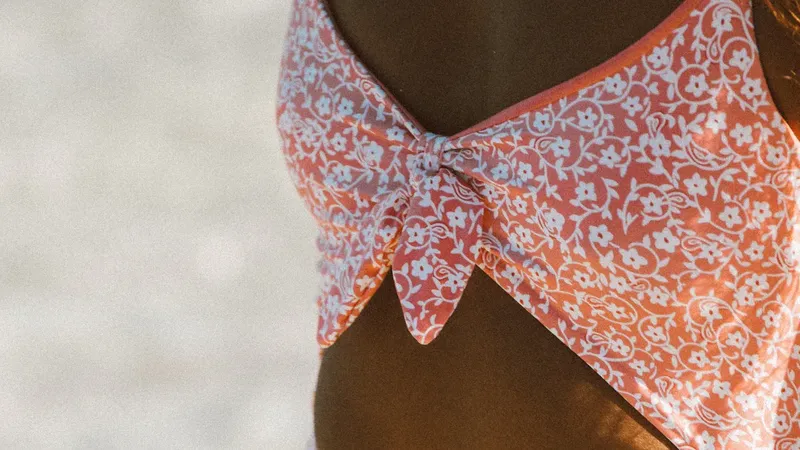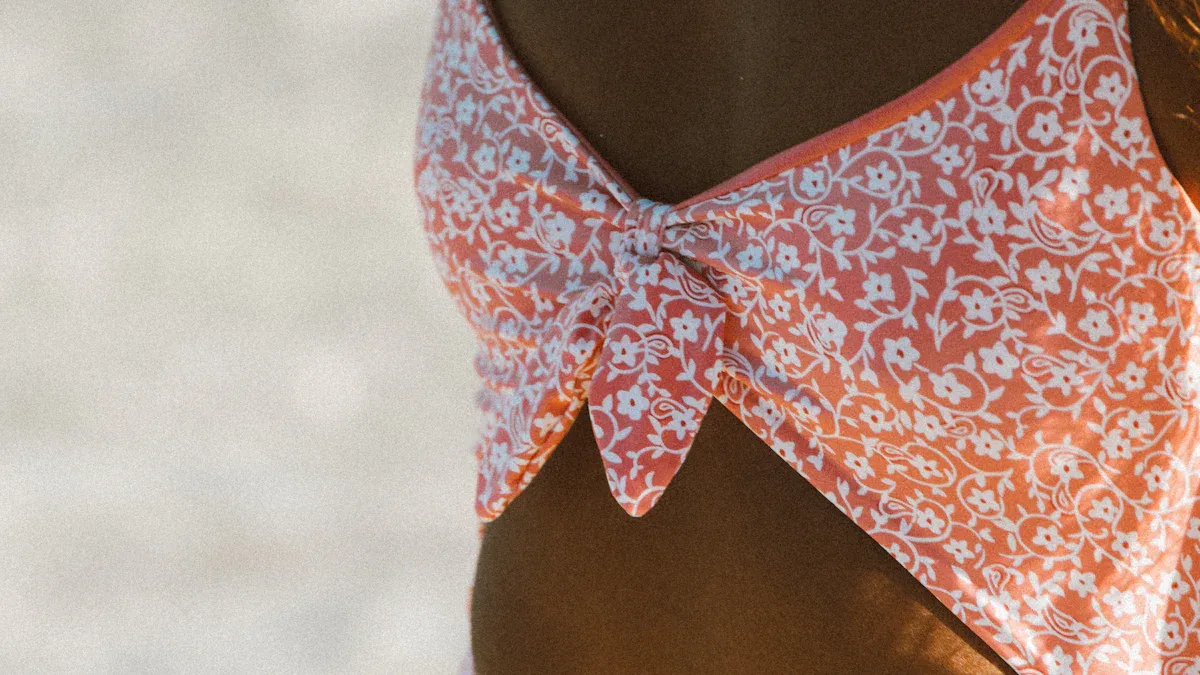
A escolha do tecido é o fator mais importante para a durabilidade e o conforto do swimwear, especialmente para um fabricante de swimwear personalizado. Diferentes tecidos influenciam quanto tempo dura o swimwear e quão bem ele se encaixa após muitos usos. O tecido também afeta como se sente contra a sua pele. Testes de laboratório mostram que as misturas de nylon-spandex esticam bem, mantêm sua forma e se sentem suaves. Misturas poliéster-spandex primam no gerenciamento de umidade e proporcionam melhor proteção solar.
Mistura De Tecido (Relação) | Estiramento (%) | Recuperação elástica (%) | Umidade Wicking (g/m² · h) | Hand-Feel Avaliação (1-10) | Estabilidade UV | Durabilidade (Ciclos Martindale) |
|---|---|---|---|---|---|---|
Nylon 75%/Elastano 25% | ~ 60 | ~ 92 (após 100 ciclos) | ~ 800 | 9 (sedoso) | Moderada | ≥ 25.000 (malha de urdidura tricot) |
Poliéster 80% / Spandex 20% | 50 ~ | ~ 90 (após 100 ciclos) | ~ 1.200 | 7 (liso) | Alto | ~ 15.000 (malha de malha jersey) |
Algodão 60%/Elastano 40% | 40 ~ | ~ 85 | ~ 400 | 8 (macio) | Baixa | N/A |
Para um fabricante de roupas de banho personalizadas, selecionar o tecido certo é crucial para produzir roupas de banho duráveis e elegantes. Tecidos inovadores, comoNylon regenerado, Agora oferecem força e estiramento comparável aos materiais tradicionais. Esses avanços ajudam a roupa de banho a durar mais tempo e proporcionam um ajuste melhor. Entender os tipos de tecido é essencial para que os fabricantes de roupas de banho personalizadas façam escolhas informadas e garantam a satisfação do cliente.
Principais Takeaways
Escolher o tecido certo ajuda a roupa de banho durar e se sentir bem. Nylon-spandex misturas esticar bem e sentir macio. Mas eles não resistem muito bem ao cloro e ao sol. As misturas de poliéster e spandex protegem melhor do cloro e dos raios UV. Eles mantêm as cores brilhantes e tornam o tecido forte. Tecidos ecológicos como ECONYL®E REPREVER®São tão fortes como tecidos normais. Eles também ajudam o meio ambiente. Tomando conta de roupas de banho,Qualidade do teste, E usando boas guarnições ajudar swimwear trabalhar melhor e fazer os clientes felizes.
Principais Qualidades De Tecido De Banho
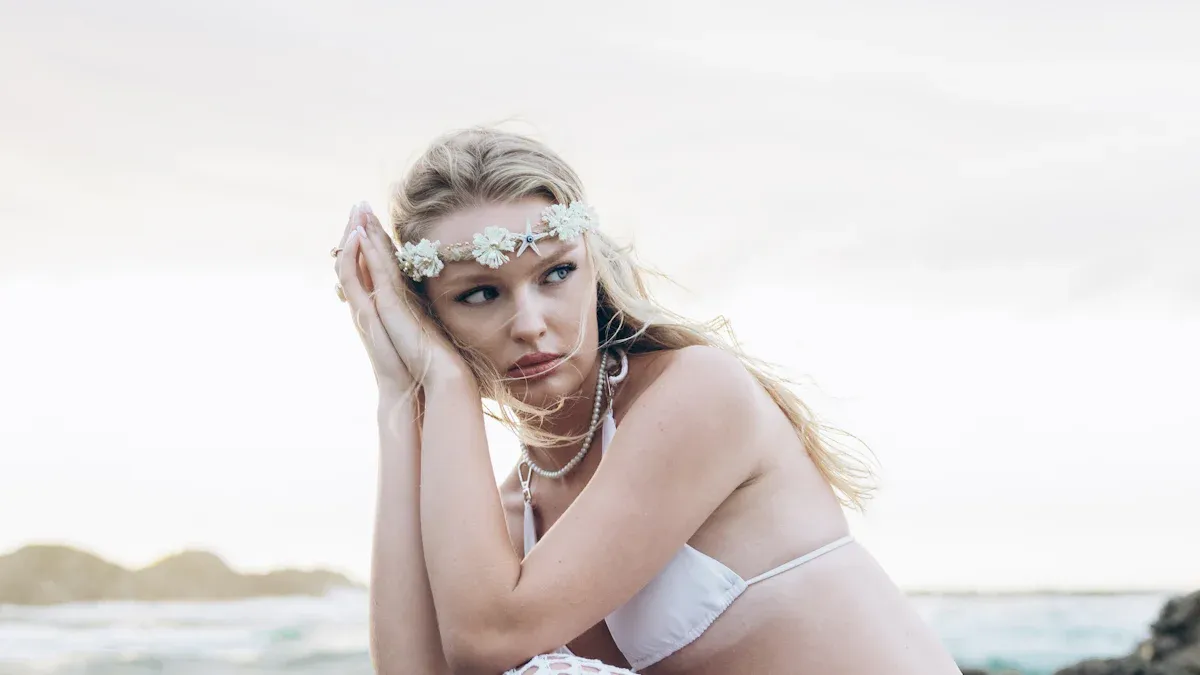
Alongamento e flexibilidade
Swimwear precisa se esticar e se mover com você. Spandex, também chamado elastano, Ajuda swimwear esticar muito. As fibras do spandex podem obter seis vezes maisE depois voltar ao normal. Isso permite que os nadadores se movam facilmente e mantenham o swimwear apertado após muitos usos. Nylon misturado com spandex é forte, elástico e se sente suave. Tecidos nervurada feitos com nylon e spandexDar suporte extra para nadadores ativos. Poliéster e spandex misturas também esticar bem e ajudar swimwear manter sua forma. Essas características tornam o swimwear confortável e duram mais tempo.
Características principais do estiramento e da flexibilidade:
Elevado estiramento para fácil movimentação
Mantém a forma após o alongamento
Luz sentir com menos volume
Suave sobre a pele
Cloro e resistência UV
O cloro e a luz solar podem prejudicar a moda praia ao longo do tempo. O poliéster é muito bom em combater o cloro e os raios UV-A. Swimwear poliéster mantém a sua cor e força mais do que outros. Nylon sente suave e se encaixa bem, mas não combate o cloro, bem como poliéster. As misturas de spandex são confortáveis e resistentes, mas o spandex sozinho quebra mais rápido em piscinas. As telas do poliéster PBT protegem melhorE manter swimwear olhar novo após muitos mergulhos.
Teste o parâmetro | Medição/Resultado |
|---|---|
Quebrando a força diminui | |
Quebrando a força diminui | 65,7% após 300 horas exposição a cloro |
Proteção UV (UPF) | 25-39 para tecidos aprimorados por PBT |
Resistência ao cloro | PBT/Poliéster: Excelente (300 + horas) |
100% Poliéster: Muito Bom (200 + horas) | |
Nylon/PBT Blend: Bom (150 + horas) | |
Spandex/Lycra: Pobre (50-75 horas) |
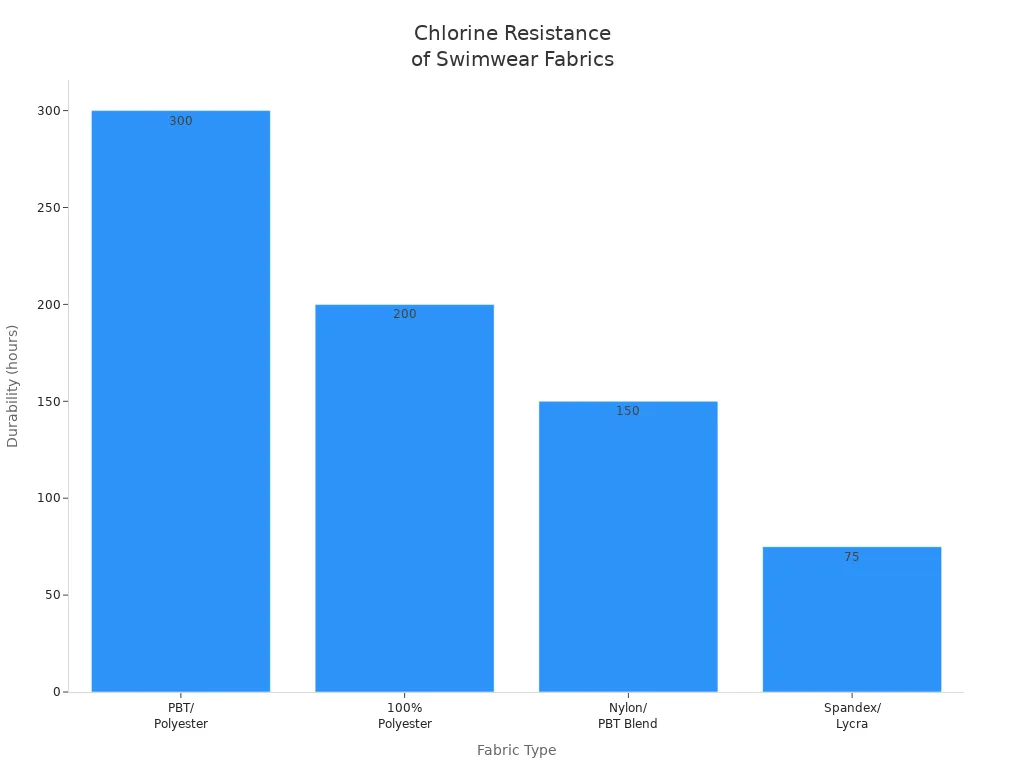
Dica: Escolha swimwear com misturas PBT ou poliéster para parar o desbotamento e flacidez. Isso é melhor para pessoas que nadam muito.
Secagem rápida e respirabilidade
Tecidos de secagem rápida e respiráveis tornam os trajes de banho mais confortáveis e úteis. Microtan®Seca sete vezes mais rápidoDo que tecido normal. Transol seca três vezes mais rápido e deixa o ar passar por pequenos orifícios. Nadadores se sentem menos molhados e podem mudar as atividades rapidamente. Swimwear respirável sente luz e não vinco, por isso é bom para viagens e esportes. Muitas pessoas gostam desses recursos e dão altas classificações para swimwear leve e de secagem rápida.
Benefícios de secagem rápida e respirabilidade:
Menos sensação molhada
Menos irritação cutânea e atrito
Design leve para fácil movimentação
Classificações altas para pessoas ativas
Os fabricantes de roupas de banho usam esses recursos para fazer produtos que duram, se sentem bem e funcionam bem em muitos lugares. Ao se concentrar no alongamento, resistência e velocidade de secagem, eles garantem que a roupa de banho atenda às necessidades de todos.
Swimwear Tecido Tipos
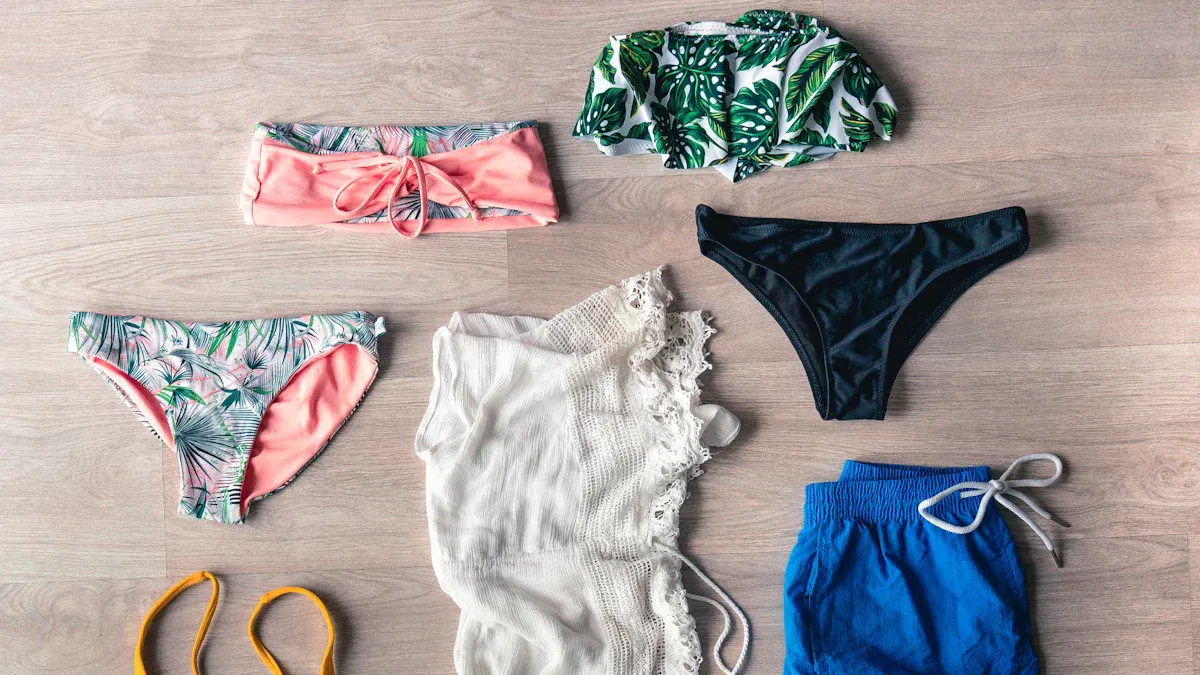
Mistura Nylon-Spandex
Misturas de nylon-spandex são uma escolha comum para swimwear. Esses tecidos misturam a força do nylon com o alongamento do spandex. Nylon ajuda o tecido a ficar forte e a se recuperar após o alongamento. Spandex, também chamado Lycra, deixa o tecidoEsticar em todas as direções-A. Isso faz swimwear caber firmemente e mantém a sua forma após muitos veste. Nylon-spandex misturas sentir macio e suave em sua pele. Muitas pessoas gostam deste conforto, especialmente para maiôs elegantes ou desenhos suaves. O tecido seca rapidamente e não rasga ou se enrosca facilmente. Mas as misturas de nylon e spandex protegem apenas um pouco do cloro e da luz solar. Com o tempo, as cores podem desbotar e o tecido pode ficar mais fraco se usado em piscinas ou muito sol. Novos materiais comoXtra Life LYCRA®Fazer misturas nylon-spandex durar mais tempo. Este tecido especial combate o cloro, o calor e os danos causados pelo sol. Ele ajuda swimwear durar muito mais tempo do que o spandex regular. Ainda assim, misturas poliéster-spandexDurar ainda mais e manter sua cor melhor-A.
Nota: As misturas de nylon-spandex são melhores quando o conforto e o ajuste são mais importantes. Custom swimwear fabricantes costumam usar este tecido porque se sente agradável e se estende bem.
Propriedade | Mistura Nylon-Spandex |
|---|---|
Conforto | Mais suave, suave, sedoso, suave na pele |
Estiramento e Elasticidade | Superior estiramento, ótimo para compressão |
Gestão umidade | Absorve o suor, menos absorção |
Secagem Velocidade | Secagem rápida |
Durabilidade | Durabilidade moderada, resiste a senões e rasgos |
Resistência UV & Cloro | Moderada |
Poliéster-Spandex Mistura
Misturas de poliéster e spandex são agora a principal escolha para swimwear forte. O poliéster protege bem do cloro, água salgada e luz solar. Este tecidoMantém a sua forma e não pílula-A. Mantém cores brilhantes mesmo depois de muitas lavagens e tempo ao sol. O poliéster seca rapidamente e manipula o suor melhor que o nylon. Isso o torna ótimo para nadadores ativos. Spandex na mistura dá ao tecido estiramento e flexibilidade. O tecido se encaixa bem, se move facilmente e fica confortável para longos mergulhos. Misturas de poliéster e spandex são boas para imprimir desenhos que duram. Fabricantes de moda praia personalizados usam essas misturas para estampas brilhantes e detalhadas. Essas misturas são testadas para garantir que durem, mantenham sua cor e mantenham sua forma. ElesCumprir normas ambientais e de segurança como Oeko-Tex e ISO-A. Custom swimwear fabricantes confiar estas misturas para a qualidade constante e bons resultados.
Misturas de poliéster e spandex têm esses principais benefícios:
Grande proteção contra cloro e luz solar
Muito forte e mantém sua forma
Seca rápido e lida com o suor
Bom para pessoas que nadam muito
Tipo tecido | Cor Retenção & Resistência UV | Durabilidade e estiramento | Notas | |
|---|---|---|---|---|
Poliéster-Spandex (com PBT) | Alto | Excelente | Muito durável, resiste alongamento danos | Ideal para swimwear competitivo |
Mais coisas boas:
Não desvanece ou se desgasta rapidamente
Spandex ajuda a esticar e caber bem
Dica: misturas de poliéster e spandex sãoMelhor para swimwearIsso precisa durar, especialmente para as pessoas que nadam frequentemente ou na água da piscina difícil.
Opções Sustentáveis
Ecológico swimwear tecidos estão ficando mais popular. ECONIL®Nylon regenerado e REPREVE®Poliéster recicladoSão as melhores escolhas. Esses tecidos usam resíduos de oceanos, aterros sanitários ou garrafas plásticas antigas. Isso ajuda o planeta, fazendo menos lixo. Tecidos ecológicos são tão fortes quanto os regulares. ECONIL®Protege bem do cloro e luz solar. REPREVER®Estica bem, mantém a cor e lida com o suor. Algum poliéster reciclado pode parecer um pouco menos macio do que o novo poliéster, mas ainda é confortável e funciona bem. Poliamidas à base de plantas, como EVO por Fulgar®, Sentir macio como algodão e vêm de plantas.
Tipo tecido | Durabilidade | Conforto Características | Impacto ambiental |
|---|---|---|---|
ECONIL®Nylon Regenerado | Combina ou excede o nylon virgem; cloro excelente e resistência UV | Macio, de alto desempenho, infinitamente reciclável | Feito de resíduos oceânicos e aterros; economiza petróleo bruto |
REPREVER®Poliéster reciclado | Durável com absorção de umidade e retenção de cor; ligeiramente menos macio do que o poliéster virgem | Bom alongamento e resistência a desbotamento | Feito de garrafas plásticas recicladas; menor pegada ecológica |
Poliamidas à base de plantas (p. ex., EVO) | Durabilidade comparável; alternativa sem plástico | Sensação macia, algodão-como | Derivado de fontes vegetais renováveis; de base biológica |
Tecidos de banho ecológicos ajudam as marcas a cuidar do planeta. Os fabricantes de moda praia usam esses materiais para atender às necessidades dos clientes de produtos ecológicos. Esses tecidos podem custar mais e precisam de pedidos maiores, mas ajudam as marcas a se destacarem.
Boas coisas sobre tecidos swimwear eco-friendly:
Muito forte e protege do cloro
Sente confortável e se estende bem
Melhor para o meio ambiente
Ajuda a fazer moda praia de forma responsável
Nota: As opções ecológicas permitem que os fabricantes de roupas de banho personalizadas ofereçam roupas de banho verdes de alta qualidade, confortáveis, fortes e elegantes.
O Papel do Spandex/Lycra no Banho
O spandex, também chamado Lycra ou elastano, é muito importante na moda praia. Deixa o tecido esticar em todas as direções. Este trecho faz swimwear caber firmemente e permite que você se mover facilmente. Xtra Life LYCRA®Protege contra danos causados pelo sol e cloro. Ele ajuda a manter a sua forma e durar mais tempo. A maioria dos tecidos tem 20% de elastano. Isso dá uma boa mistura de alongamento, respirabilidade e força.
Spandex/Lycra ajuda swimwear por:
Deixando-o esticar em todas as direções
Mantendo seu ajuste e forma após muitos usos
Tornando-o mais forte contra o cloro e a luz solar
Adicionando conforto e fácil movimento
Custom swimwear fabricantes usam misturas de spandex para fazer swimwear que se encaixa bem e dura. As equipes de qualidade verificam esses tecidos para garantir que eles esticam, duram e se sentem bem.
Seleção De Tecido Para Fabricantes De Swimwear Personalizado
Testes e Certificações Qualidade
Custom swimwear fabricantes usar forte qualidade cheques. Eles querem que todos os maiôs sejam seguros e funcionem bem. Cada tecido é testado quanto à força, conforto e desempenho-A. Estes testes acontecem em laboratórios especiais e também na vida real. OA tabela abaixo mostra alguns testes e por que eles importam:
Teste Aspecto | Padrão (s) | Finalidade/Descrição |
|---|---|---|
Estiramento e recuperação de 4 vias | ASTM D3107, ISO 14704-1 | Mede a elasticidade do tecido e a capacidade de retornar à forma original. |
Estiramento e recuperação | ASTM D4964, EN 14704-1 | Testa elasticidade e recuperação após puxar. |
Resistência à tração | ISO 2062 | Avalia a força do fio e estique antes do rompimento. |
Resistência do cloro | TM147 AATCC | Avalia a durabilidade do tecido contra a exposição ao cloro. |
Coridez | ISO 105-C06, ISO 105-X12, ISO 105-E04 | Verifica a retenção da cor após lavar, esfregar e suar. |
Resistência a abrasão | Martindale (ISO 12947), ASTM D4970 | Testa a resistência a pilling e desgaste. |
Eles também verificam a proteção UV, a rapidez com que o tecido seca e o quão bem ele afasta o suor. As pessoas experimentam amostras para ver se a roupa de banho se sente bem e funciona na água. Antes de fazer muitos trajes de banho, eles escolhem o tecido, fazem amostras, encaixam-nas e corrigem qualquer problema. As equipes verificam todos os grupos de trajes de banho para garantir que sejam todos iguais.
Certificações são muito importantes para swimwear. Padrão 100 Oeko-TexÉ o mais usado. Isso significa que o tecido não tem nada prejudicial e é seguro para as pessoas. Alguns fabricantes também recebem Oeko-Tex STeP ou GOTS para segurança extra e cuidado com o planeta. Essas certificações ajudam os clientes a confiar na marca e mostram que a empresa se preocupa com a segurança e o meio ambiente.
Dica: Sempre escolha swimwear com boas certificações. Isso significa que o tecido é seguro, de alta qualidade e feito da maneira certa.
Feedback do cliente e uso no mundo real
Opiniões do cliente ajudam os fabricantes a escolher os melhores tecidos-A. Eles perguntam às pessoas o que pensam por pesquisas, avaliações e formulários de feedback. Isso os ajuda a saber o que as pessoas gostam ou não gostam em trajes de banho. Makers usam esse feedback para:
Dê mais opções para maiôs personalizados.
Faça projetos melhores de ideias reais do usuário.
Construa confiança ao ouvir os clientes.
Encontre novos estilos ou materiais ecológicos.
Escolha tecidos que durem, se sintam bem e sejam verdes.
Continue melhorando a moda praia e siga novas tendências.
Os fabricantes também analisam como os tecidos funcionam na vida real. Eles medem estiramento, recuperação, cloro e resistência UV, desgaste da água salgada, controle do suor, tempo de secagem, respirabilidade, compressão e poder de permanência da cor. OA tabela abaixo mostra números importantes:
Aspecto Desempenho | Métricas/Valores | Finalidade/Impacto |
|---|---|---|
Tecido Stretch | 30-60% alongamento na ruptura | Permite ajuste do contorno do corpo e liberdade de movimento |
Recuperação elástica | > 90% recuperação após 50 ciclos na tensão 15% | Mantém a compressão e evita a flacidez |
Resistência do cloro | > 90% retenção elástica após 100h no cloro 10 ppm | Garante durabilidade em ambientes piscina |
Resistência UV | 75-90% de retenção de força em 100-200 kJ/m² dose UV | Protege a integridade das fibras e a estabilidade das cores |
Água salgada abrasão | 3-10% aumento da abrasão após 10-50 ciclos de sal | Mede o desgaste do tecido pela exposição ao sal |
Taxa de absorção de umidade | 0.8-1.2 cm/s (acabamentos hidrofílicos) | Retira a água da pele para o conforto |
Secagem Tempo | 5-8 minutos (com acabamentos hidrofílicos) | Acelera a evaporação para reduzir os calafrios |
Respirabilidade (MVTR) | > 8.000g/m² · 24 h | Permite a circulação do ar, reduz a umidade |
Níveis compressão | 10 a 20 mmHg | Estabilização muscular e redução do arrasto (até 7%) |
Peso do tecido | 140-250 g/m² | Balança compressão, alongamento e durabilidade |
Solidez Cor | Testado via protocolos laboratoriais | Garante a retenção da cor após exposição e lavagem |
Durabilidade do acabamento | 20-40 ciclos de lavagem para acabamentos hidrofílicos e DWR | Indica longevidade dos tratamentos do tecido |
Algumas marcas usamMaiôs inteligentes com sensores-A. Esses sensores rastreiam coisas como frequência cardíaca e velocidade do nado. Isso ajuda os fabricantes a ver como o tecido funciona quando as pessoas nadam.
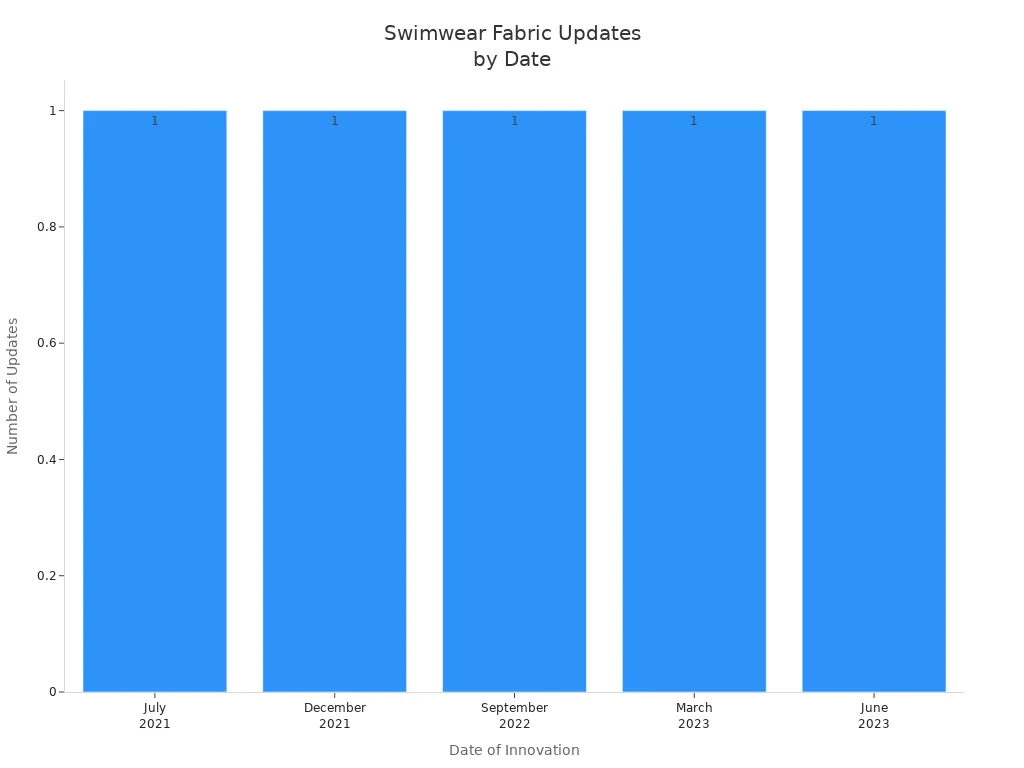
Fabricantes mudam suas escolhas tecido muitas vezes, às vezes a cada temporada. Isso ajuda a roupa de banho a ficar nova, confortável e a funcionar bem.
Guarnição e materiais adicionais
Bons acabamentos e materiais extras importam tanto quanto o tecido principal. Guarnições são coisas como elásticos, forros, zíperes, ganchos e decorações. Estes devem ser fortes e não quebrar em cloro, água salgada ou luz solar.
Hardware à prova de ferrugem e forros macios tornam os maiôs melhores.
Guarnições ecológicas comoECONIL®E elastano forteCombater cloro, cremes solares, e óleos.
As guarnições de proteção UV ajudam os maiôs a durar e proteger a pele.
O trabalho cuidadoso e a criação local ajudam a controlar a qualidade.
Apara fortes significam menos reparos e clientes satisfeitos.
Nota: Escolher boas guarnições e materiais interrompe problemas como pontos soltos, costuras fracas ou mau ajuste.
O impacto da qualidade do tecido no produto final Swimwear
A qualidade do tecido muda como o swimwear funciona e como os clientes estão satisfeitos-A. Bons materiais esticam bem, secam rápido e combatem o cloro e o sol. Usar o mesmo material sempre significa que os maiôs combinam amostras e têm menos erros. Testar a cor mantém os maiôs parecendo novos, o que deixa os clientes felizes.
Verificações cuidadosas durante a fabricação, como olhar para tecidos e testes, mantêm o bom nome da marca. Principais materiais como Lycra e spandexDurar muito tempo, sentir-se bem e trabalhar bem. Obter tecido de fornecedores confiáveis com certificações significa que os maiôs são seguros e de alta qualidade.
Erros comuns não são verificar o alongamento, usando pouco elastano, Ou pegar fibras naturais que absorvem água. Esses erros podem fazer maiôs ceder, se sentir mal, e não durar. Fabricantes testam todos os tecidos e trabalham com bons moinhos para evitar esses problemas.
Custom swimwear fabricantes muitas vezes adicionar novas opções tecnológicas e eco-friendly para seus tecidos. Isso mantém seus maiôs frescos e os ajuda a competir.
Escolher o tecido certo é muito importante para a moda praia. O tecido afeta quanto tempo a roupa de banho dura e como se sente. Swimwear funciona diferente por causaDo que é feito, quanta água absorve e como o exterior parece-A. Alguns maiôs especiais, comoTernos de corpo inteiro e tecidos de compressãoAjudar os nadadores a ir mais rápido. Eles fazem isso fazendo menos arrasto e ajudando os músculos a trabalhar melhor. Fabricantes que se preocupam com qualidade e testam seus produtosFazer melhor swimwear. Eles também ouvem o que os clientes querem. As marcas continuam melhorando os trajes de banho experimentando novos materiais e pedindo feedback-A. As melhores marcas de moda praia permanecem populares usando novas ideias, cuidando do planeta e fazendo produtos de alta qualidade.
Marcas de banho que se preocupam com qualidade e seguem novos estilos mantêm seus clientes voltando.
Quão bem a roupa de banho funciona depende do tecido, qualidade e novas ideias.
Os fabricantes de moda praia personalizados devem sempre testar, ouvir e melhorar as coisas.
FAQ
Qual tecido dura mais tempo em swimwear?
Misturas poliéster-spandexSão os mais fortes para swimwear. Estes tecidos não são danificados pelo cloro ou luz solar facilmente. As misturas de nylon não duram tanto quanto as misturas de poliéster. A maioria das marcas de moda praia usa poliéster porque é resistente e mantém sua cor.
Dica: Escolha swimwear poliéster se você nadar muito em piscinas.
Como o spandex melhora o conforto do swimwear?
Spandex ajuda swimwear esticar e mover com você. Swimwear com spandex se encaixa bem e se move quando você faz. Esta fibra mantém a forma e pára flacidez após muitos usos.
O Spandex oferece esses benefícios:
Melhor movimento
Fica no lugar
Sente suave
São tecidos swimwear eco-friendly tão forte quanto os tradicionais?
Tecidos ecológicos como ECONYL®E REPREVER®São tão fortes quanto nylon regular e poliéster. Esses tecidos reciclados não se decompõem do cloro ou da luz solar. Eles funcionam bem para pessoas que nadam muito.
Tipo tecido | Durabilidade | Impacto ecológico |
|---|---|---|
ECONIL® | Alto | Excelente |
REPREVER® | Alto | Excelente |
Como a roupa de banho deve ser cuidada para prolongar sua vida?
Enxágue a roupa de banho com água fria após usá-la. Não torça ou coloque-o na secadora. Coloque-o plano para secar longe do sol. Essas etapas ajudam a manter o alongamento e a cor.
Nota: Cuidar de roupas de banho pára desbotamento e danos.
